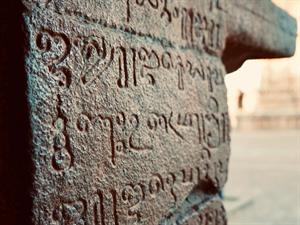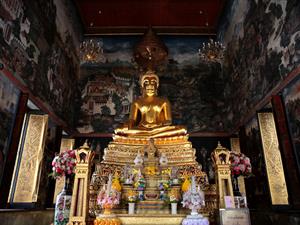PDF chapter test TRY NOW
Buddhism in Tamil Nadu:
1. Buddhism set its foot in South India during the \(2^{nd}\) \(\text{Century BC}\), the period of the \(3^{rd}\) Sangam, which was long after the advent of Jainism in Tamil Nadu. Buddhist monks from various parts of the world visited Kaveripattinam, located on the eastern coast of Tamil Nadu.
2. Manimekalai, an ancient Tamil epic is Buddhist literature that speaks volumes about the tenets of Buddhism. It was written by Seethalai Saththanar who translated many Buddhist and Pali terms into Tamil language.

Inscriptions on Buddhism in Tamil Nadu
3. Hieun-T-Sang, a Chinese chronicler belonging to the \(7^{th}\) Century wrote about the Pandyan kingdom of Madurai and the stupa built by the ruler at that time.
Buddhism flourished during Pallava rule in \(\text{400 – 650 AD}\) and also during the Chola period from the \(9^{th}\) Century to \(14^{th}\) Century.
Kanchipuram: This place was considered the greatest centre of Buddhist learning, which was also mentioned in the Tamil epic Manimekalai.
4. Mahendravarman the ruler of the Pallava dynasty wrote about Buddhism in his Sanskrit work “Mattavilasa Prahasana”. Famous Buddhist scholars like Dharmapala, and Dinnaga belong to Kanchipuram.
5. Many great scholars like Bodhi Dharma, Buddhagosha, Dharmakirthi and Chandrakirthi belonged to Tamil Nadu.
The emergence of the Bhakti Movement and its consequences:
Buddhism co-existed with Ajivika and Jainism, other contemporary religions of Tamilnadu. Since the advent of the Bhakti movement, they started developing songs and exerted principles that challenged the dominance of Buddhism.
The Shaiva and Vaishnava saints composed various poems which infused the religious tenets of Shaivism and Vaishnavism among the People. Buddhism went on a decline from that period.
Poompuhar was a port city of Tamil Nadu that felt the presence of Buddhist scholars of Ceylon, Buddhist monasteries are found in Poompuhar.
Nagapattinam also contains Buddhist monasteries and they are called the Monastries in the name of Pudhuveli gopuram.
Chudamani Vihara: Nagapattinam also had the Patronage of the Chola rulers which was seen in Chudamani Vihara which was built by Sri Vijaya King.
The Sanghas of Buddhism:
Buddha decided to spread the truths of life he acquired through rigorous meditative practices, for that purpose he had established an association of monks (who were known as “Bikhus/ Bikhuni’s).

Vihara / Monastery
This association of monks are taught with Buddhist principles, who followed the life of austerity. The Insolvents, Slaves and diseased people were not allowed to participate in Sanghas.
Women were allowed to participate in Sanghas during later periods. They were also allowed to be monks in monasteries.
Monastries: Are also known as the Vihara’s where the monks stayed, which are built near the Chaitya’s (Place of worship/ Meditation hall of the monks).
Buddha asked his followers to avoid extreme practices of penance and luxury, so he advocated a path named “Madhya Marg/ The Middle Path” to strike a balance in life.
In Kaveripoompattinam a coastal town in Tamil Nadu a Buddhist Vihara was found which contained numerous Buddha statues.
